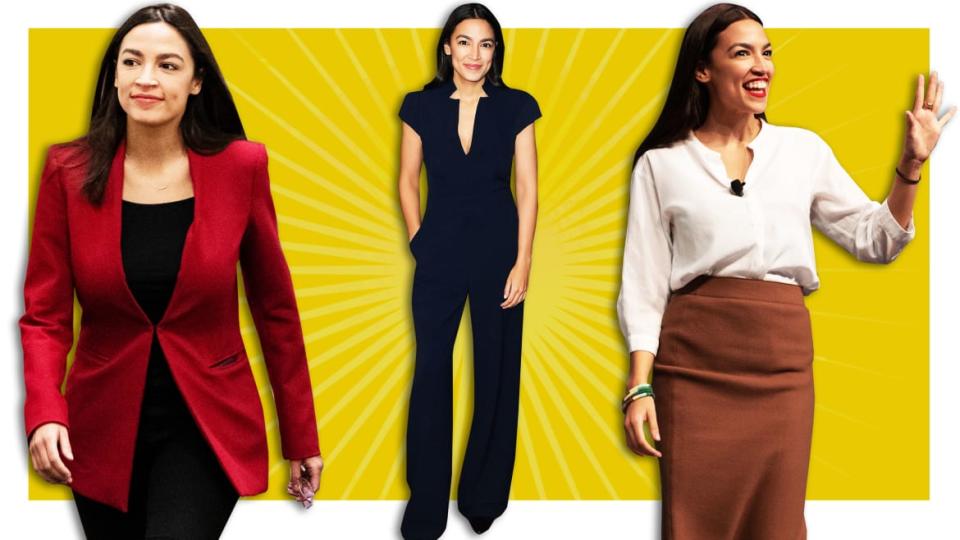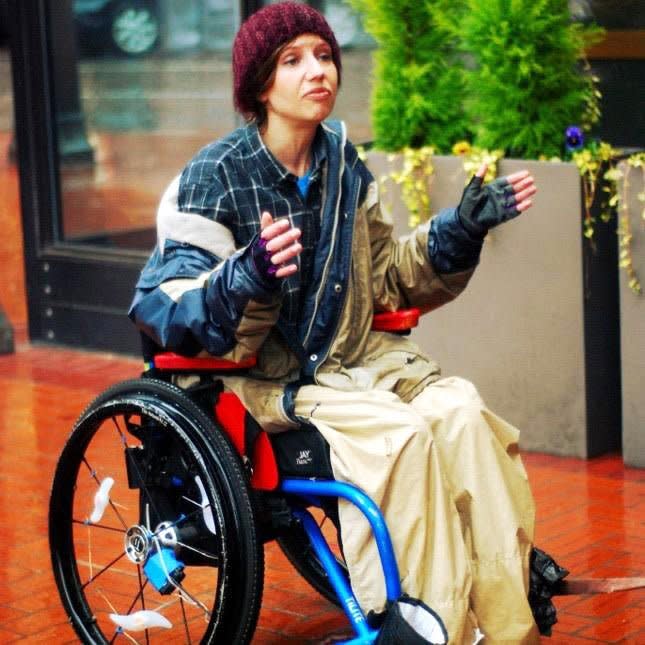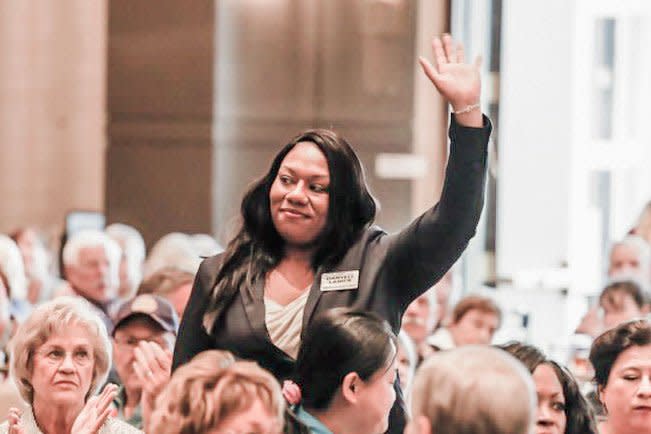Can AOC Inspire Female 2020 Candidates to Dress How They Damn Well Want?

On Wednesday, Rep. Alexandria Ocasio-Cortez (D-NY) appeared on The View in a shiny $580 dress from Rickie Freeman. It was, even by nonpartisan standards, a great look. Yet, as the New York Post reported, conservatives leapt to predictably criticize Ocasio-Cortez about the outfit.
Ocasio-Cortez responded to the Post and her critics via an excellent tweet: “Yep! I rent, borrow, and thrift my clothes. (It’s also environmentally sustainable!) The Post is just mad that you can look good fighting for working families. Sequins are a great accessory to universal healthcare, don’t you agree?”
Just a day before AOC stopped by ABC studios, the New York women’s workwear company M.M. LaFleur announced in an email that it would provide free outfits to any female candidate running for office in 2020— “whether it be for the House of Representatives or your town council.”
It’s not an entirely surprising offer from the brand, founded in 2011 by former financial consultant Sarah Miyazawa LaFleur. Cynthia Nixon wore the label during her failed run for New York governor. Rep. Stephanie Murray (D-FL) has also been seen in the simple, but sleek, clothes, which would not look out of place in an old Veep episode.
The trousers and skirts live in that diplomatic, focus group-tested land of fitted, not tight. The shirts come in the most subdued versions of primary colors known to (wo)mankind. One of M.M. LaFleur’s most popular items, is the cutely-named “jardigan,” which, obviously, is a cross between a jacket and a cardigan. Models wear it with ease, over silk shirts and pencil skirts. It’s enough to make you wonder if you’re too old to apply to law school.
Basically, M.M. LaFleur promises shoppers the same type of uncomplicated style that Ann Taylor once did, before that name became a punchline. (If Ann Taylor reminds you of a conservative housewife’s church clothes, think of M.M. LaFleur as a go-to for her sister who moved to the city and collects vintage copies of Little Women).
The most edgy thing about M.M. LaFleur might be its pricing—$265 for a three-quarter-length sleeved slate gray dress, $145 for a black mock neck top that’s billed as “wrinkle-resistant.” Not accessible, perhaps, for a self-funded grassroots candidate. So the free clothes will help.
Except, as LaFleur noted during a phone call with The Daily Beast, the candidates will not be able to keep clothes after election day. “We are lending the clothes to these candidates, we’re not giving it to them,” she said. “When they’re done with the clothes, we’re asking them to donate to Bottomless Closet,” a woman’s organization that provides job-hunters an interview wardrobe.
As pointed out by The Washington Post, LaFleur will purchase her own clothing and gift it to candidates running for federal positions, so as to not violate campaign finance laws. Those rules vary from state to state. “We have put in our T&C (terms and conditions) and asked candidates who have written in to make sure that they’re complying with their local campaign laws,” she told The Daily Beast.
According to LaFleur, over 875 people have written into the company’s designated email address expressing interest in the program. “The number is changing by the hour,” she said. “I think we’re going to have to introduce a cap,” on the number of donations. She declined to say when that limit will be reached.
The day after the 2016 election, LaFleur planned to send out a “Pantsuit Email” blast after what she assumed would be a victory for Hillary Clinton. “We ended up sending what we called a ‘Call to Conversation,’ with our customers,” LaFleur said. “Whether you’re a Republican or Democrat, that day was surprising. We wanted to hear how we could continue to support women in politics.” After “noodling” with a few different ideas, she decided to donate clothing.
AOC’s glitter top is fabulous. M.M. LaFleur is what you throw on when you’re running late. But female candidates, especially the ones who haven’t yet nabbed a Drag Race guest-judge spot, cannot exactly pander to trends. They often find a style that’s identifiable, yes—see: Elizabeth Warren’s revolving door wardrobe of gemstone jackets and black pants—but it’s rarely flashy.
“Function will ultimately never expire when it comes to what [political] folks are looking for from quote unquote ‘fashion,’” Lauren A. Rothman, a stylist based in D.C., said. “I specifically mean ‘fashion’ with quotes. Most of my clients are not into fashion. It’s another box that needs to be checked, like everything else. How’s my speech? What does transportation look like today? What am I wearing today? It’s a uniform.”
Whether M.M. LaFleur will ultimately be the uniform of Democratic women this election season is yet to be seen. Imagine, for a moment, hundreds of women campaigning for the same position, all wearing the same outfit. A little unsettling, no?
“I get asked all the time if there’s a shortcut to style,” Rothman said. “There are so many tools out there to help you access style. But in the end, great style must be personalized. It must be, on some level, authentic to who you are.”
So advice to potential jardigan owners (or borrowers, as the case may be): “If everyone on stage is wearing M.M. LaFleur, you’ve got to do something with it,” Rothman said. “Add a lipstick, jewelry, a great pop of color shoe. Make the look yours.”
Yasmine-Imani McMorrin

Yasmine-Imani McMorrin is an attorney and single mom running for a seat on the city council of Culver City, California. After she decided to run, McMorrin made some edits to her wardrobe, buying heels (she’s a fan of flats), and clothes in “palatable” colors like “grays, blacks, navys, and hunter greens.”
“I’m not saying I’ve shifted everything, but I’ve made a conscious effort shopping holiday sales, taking advantage of sales where I can, to make sure that I have some staple pieces to pull in,” McMorrin said. “It’s a long way until November.”
Growing up, McMorrin’s father would do an “evaluation” of her outfits before she left the house. “My father is Jamaican, and we were a representation of him and our culture,” she said. “It’s very important to present in a certain way and behave in a certain way out in public. Because of that, I already internally have that little test for whatever I wear as I engage in the world.”
In the winter, fall, and spring, McMorrin gets blowouts for her hair, but in the summer, she wears her hair naturally curly. “People are just going to have to roll with it,” she said. “If you look at other women of color recently, like those in the Squad and Stacey Abrams, you’ll see them wearing curly hair, red lipstick, hoops, bringing more of themselves into these traditionally conservative white male spaces. We’re not there yet, but there are little things we’re slowly chipping away at.”
Amanda Siebe

In Beaverton, Oregon, Amanda Siebe hopes to unseat incumbent Suzanne Bonamici and become a member of the U.S. House of Representatives. After falling at work in 2011, she was diagnosed with Reflex Sympathetic Dystrophy (RSD), a nerve disorder that causes chronic pain. She now makes $750 a month on social security disability, and part of her platform involves workers’ rights and protections. She has reached out to M.M. LaFleur for help.
“I was looking at M.M. LaFleur’s website the other day, to see what their clothing costs,” Siebe said. “It costs as much for a dress as half of my monthly salary. There is no way I’d be able to compete without having an opportunity like this. I’m relying on Goodwill and hand-me-downs.”
But thrift finds are notoriously unreliable, fit-wise, especially for someone who uses a wheelchair. “Because of my disability, it’s already hard for people to approach me,” Siebe explained. “If I wear the clothes I would normally go out in—no makeup, jeans, a T-shirt—just trying to campaign, no one would even talk to me. If I don’t look extra-professional, don’t have what people expect politicians to look like, people pass me over without a second thought.”
This might be changing—Siebe said that younger voters “like the fact” that she’s “just an average person.”
“That’s what we really need in Congress,” she said. “We don’t need more multibillionaires. It sucks that you have to look like that even to be taken seriously as a legitimate candidate.”
Lauren Ashcraft

Lauren Ashcraft wants to serve as a progressive congresswoman for New York’s 12th District, which serves the East Side of Manhattan, Greenpoint, Brooklyn, and western Queens. Her daily outfit—which she sometimes wears to her part time fundraising job at the East Village’s Middle Collegiate Church—are black trousers, a blazer, and her own campaign T-shirt.
“At this point, I’m about to enter into the petitioning part of the campaign, so we need thousands of signatures to get on the ballot,” Ashcraft said. “Every minute that I can spend not thinking about what I’m wearing is another couple of signatures.”
So, she prefers to keep it simple. With one exception. “AOC wore a glittery top on The View,” Ashcraft said. “My backpack is glittery! You’ll see shots of it in the videos we put out there. You’re never going to see a dampened version of me. I’m always going to bring some glitter out there. Sometimes it’s my nails, or a piece of jewelry that means something to me.”
Rachel Ventura

In Illinois’ 11th District, which progressive Democrat Rachel Ventura hopes to win in November, two-thirds of people make less than $15 an hour. “I need to take that into account when I’m in D.C.,” Ventura said. “It saddens me a little bit, because there’s this perspective that all of our people in Congress are well-to-do. The reality is most of America is not in that place in their own lives. I plan to wear suits on the floor of the House, but I also plan to have behind-the-scenes looks, like a normal person. I have the same problems other people have—shoes with worn-out holes, scuffed tops, overstretched jeans and T-shirts.”
Before announcing her candidacy last summer, Ventura went to a thrift store that sells professional clothing. “I tried on 300 outfits,” she said. “Basically everything they had in the store. But thrift stores are hard to shop at.”
A friend recommended the clothing rental company Le Tote. Every month, Ventura is sent eight pieces of clothing, which she wears and sends back. If she falls in love with any of the pieces and wants to keep them, she’ll pay anywhere from $50-$100, on top of the $80 a month for her subscription. “It’s not exactly in my mom budget,” she admitted.
Danyell Lanier

The last woman to represent Oklahoma’s 2nd District, a predominately rural section on the eastern side of the state, was Alice Mary Robertson. She served from 1921 to 1923. Since then, the state’s representatives have been men, each sporting crew cuts and red or blue ties in their official portraits. Danyell Lanier wants to change that.
The Navy vet and mother will run as a Democrat against Rep. Markwayne Mullin (R-OK). “In Oklahoma, cowboy boots are the norm,” Lanier said. “The guy that I’m running against, when he’s meeting with people, that’s what he has on—North Face vest, button down, jeans, and boots. That’s just how it is. For a woman, it’s different. People don’t really understand the pressure we’re always facing about what we have on.”
When Lanier decided to run, she had to say goodbye to her beloved distressed skinny jeans. She bought, for the most part, an entirely new wardrobe. “That is not deductible, that’s not something you can write off,” she said. “You’re investing in yourself, your image. That’s out of pocket. And you might not want to keep wearing that same black blazer, so you go look for one in another color. There are little nuances no one thinks about—runs in pantyhose, zippers break, you have to be prepared for that.”
She keeps an “emergency bag” in her car filled with a blazer, slacks, a pair of loafers or heels, just in case she finds herself running to an event. “I’m a veteran, so I’m accustomed to wearing a uniform,” Lanier explained. “This is the first thing they see before I even speak. Fashion is a silent, powerful statement.”
When Lanier meets her potential constituents, she is “able to see the respect that they have for me showing I can dress the part. You can recognize this is how I represent you.”
It’s time for a changing of the guard in Oklahoma’s 2nd District, Lanier thinks. “And if that means taking off the boots and putting on kitten heels, I’m willing to do that,” she said.
Get our top stories in your inbox every day. Sign up now!
Daily Beast Membership: Beast Inside goes deeper on the stories that matter to you. Learn more.

